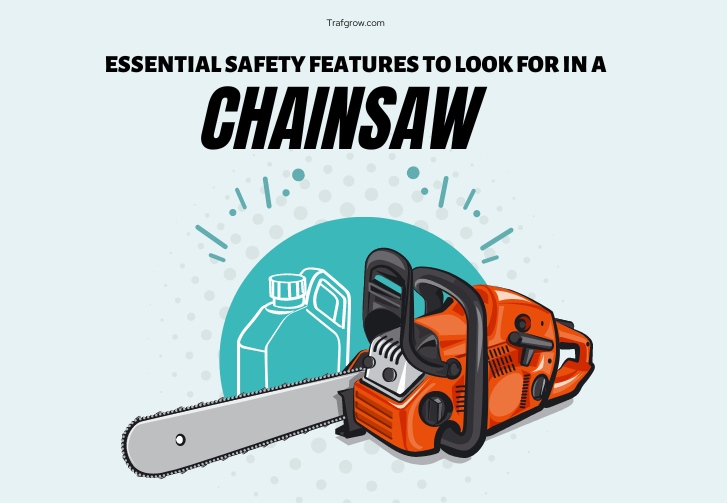
Safety Features to Look for in a Chainsaw
Chainsaws are dangerous and powerful tools that may require caution and care while operating. Several essential safety features to look for in a Chainsaw should be considered when purchasing a chainsaw. This blog post will explore the critical safety elements that all chainsaw users should prioritize.
Essential Chainsaw Safety Features You Shouldn’t Overlook
When best chainsaws shopping, the first thing to assess is the overall build and design. Sturdy construction and ergonomic shaping provide the fundamental framework for safe use. Look for balanced chainsaws made from durable materials with non-slip grip handles. These basics allow for proper control and reduce fatigue.
Kickback Safety Features
One of the biggest hazards when using a chainsaw is kickback, when the tip of the saw blade catches and flings back aggressively. Multiple safety additions help prevent and reduce kickbacks.
First, look for the best electric chainsaw with minimal kickback tendencies. The shape and depth of the tooth gullets impact kickback risk. Then, ensure the model has safety features to look for in a Chainsaw to reduce kickback when it does occur. Chain brakes are essential – these stop the chain instantly if kickback is detected. Front and rear hand guards provide further protection. Anti-vibration mechanisms also help the user maintain control if a kickback happens.
Chain and Guide Bar Safety
The guide bar and chain do the actual cutting, so their design elements significantly influence safety. The chain should be the correct gauge for the guide bar length, allowing for smooth function. Safety chains with specialized depth gauges and preventing over-filing help reduce kickback potential.
Guide bars often come with safety tips engineered to reduce kickback risk. Look for guide bars with sturdy, durable construction for consistency and safety during use. Proper chain tension and lubrication are also crucial for safe operation.
Read also: overview of Water tube steam boiler
Safety Switches
Look for a chainsaw with multiple automatic switch mechanisms that add control and prevent accidental start-ups or engagements. The most vital switch is a trigger lockout that prevents the trigger from being pulled until manually unlocked. It prevents accidental trigger pulling.
Another essential safety addition is an automatic chain brake that engages every time the engine turns off. Some models also have a throttle trigger lock that the engine must engage. These switches provide control.
Harnesses and Protective Equipment
While not built into the saw, safety harnesses and protective equipment are crucial to safe chainsaw operation. Look for harnesses that allow freedom of motion while providing support if kickback occurs. Always use proper footwear, eyewear, hearing protection, and leg chaps when running a chainsaw.
Additional Safety Mechanisms
Other beneficial safety features include chain catchers that grab broken chains, hand guard over-moulding for vibration reduction, decompression valves for easy starting, and inertia-activated chain brakes. Consider models with multiple mechanisms to enhance safety.
Maintaining Your Chainsaw for Continued Safe Use
Keeping your chainsaw running safely over time through proper maintenance is essential. Here are some key upkeep tips:
Regular Tuning and Inspections
Routinely check the tension and sharpness of the chain. Make sure the lubrication system works and lubricate the chain. Inspect components for damage. Tune up the engine when needed.
Use Recommended Fuel and Chain Oil
Use the type and grade of fuel and chain/bar oil specified in the owner’s manual. Old or improper oil and fuel can be dangerous.
Read also: Coupling Bushes in Mechanical Systems
Replace Worn Parts
Immediately swap out damaged or excessively worn components like the chain, guide bar, or spark plug. Use manufacturer-recommended replacement parts.
Clean Built-Up Debris
Remove built-up debris like dirt, sawdust and pitch off the guide bar, chain and engine. Debris can hinder performance.
You can safely operate your saw by selecting a chainsaw with essential safety features and properly maintaining it. Take your time with safety with this powerful equipment.
Frequently Asked Questions
What safety gear should you use with a chainsaw?
Use proper protective equipment like chainsaw chaps, steel-toe boots, hearing protection, eye protection, and heavy leather gloves. A helmet and chainsaw protective jacket are also recommended.
Do more expensive chainsaws have more safety features?
More expensive professional-grade models generally have more kickback protection, chain brakes, enhanced materials, and other safety mechanisms. Homeowner models may need some features.
What maintenance helps improve chainsaw safety?
Sharpening the chain regularly, replacing worn parts, cleaning debris buildup, using proper fuel and chain oil, and tuning up the engine all help keep a chainsaw running safely.
Can you remove safety features from a chainsaw?
Removing any safety features is not advisable as this increases the risk of injury. Chainsaw safety mechanisms are designed to protect the user. Removing them makes the operation more dangerous.
What causes chainsaw kickback?
Kickback happens when the saw blade tip catches on something, causing the blade to flick back toward the user aggressively. Improper saw handling can increase kickback risk.
Conclusion
Chainsaws are hazardous power tools that require safety precautions. Look for models with kickback protection features, chain brakes, sturdy construction, and ergonomic design. Properly maintain your saw and always use protective gear. With the right saw and safe operating procedures, chainsaws can be used confidently to achieve the task. Pay attention to safety when using these powerful cutting tools.







